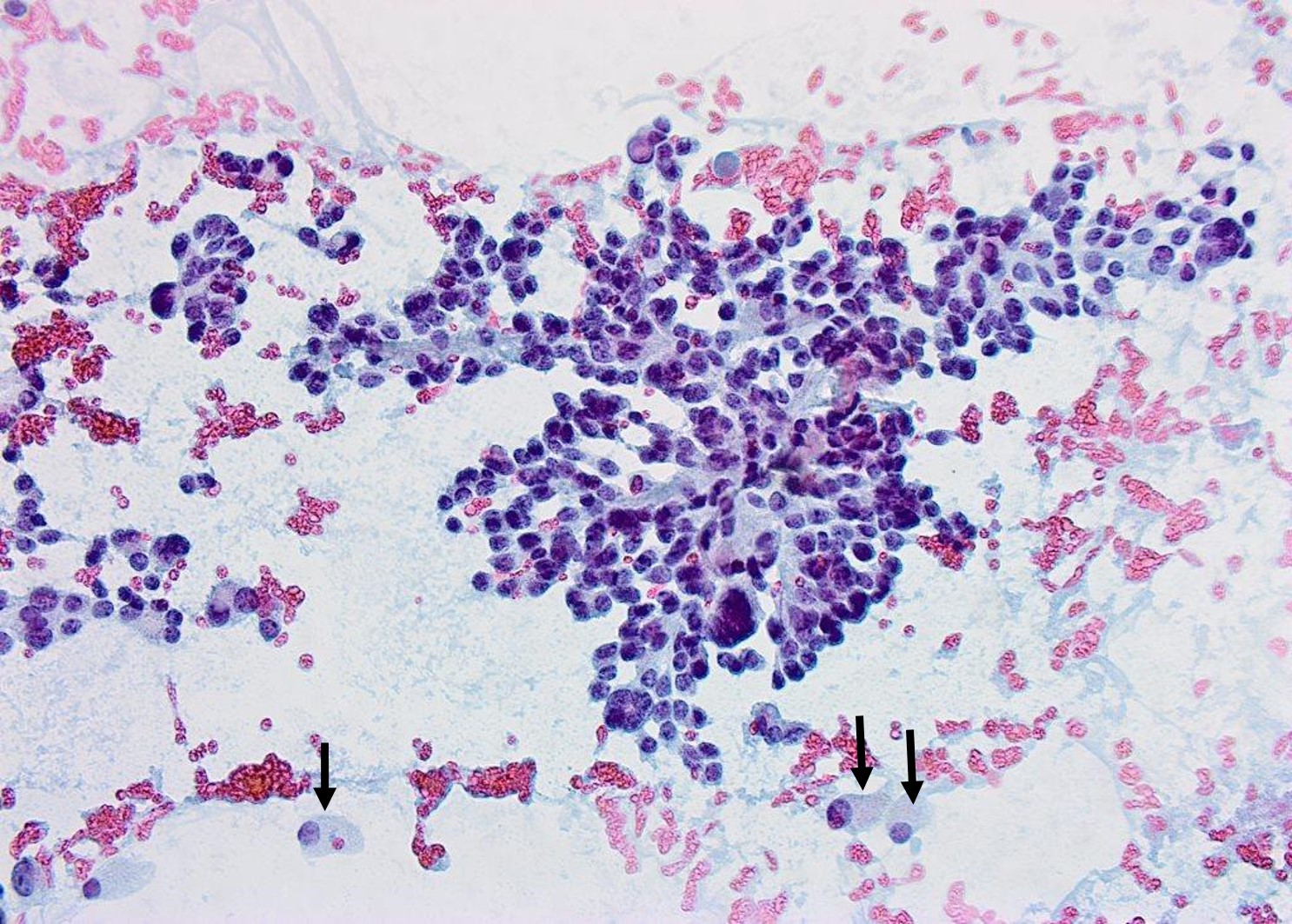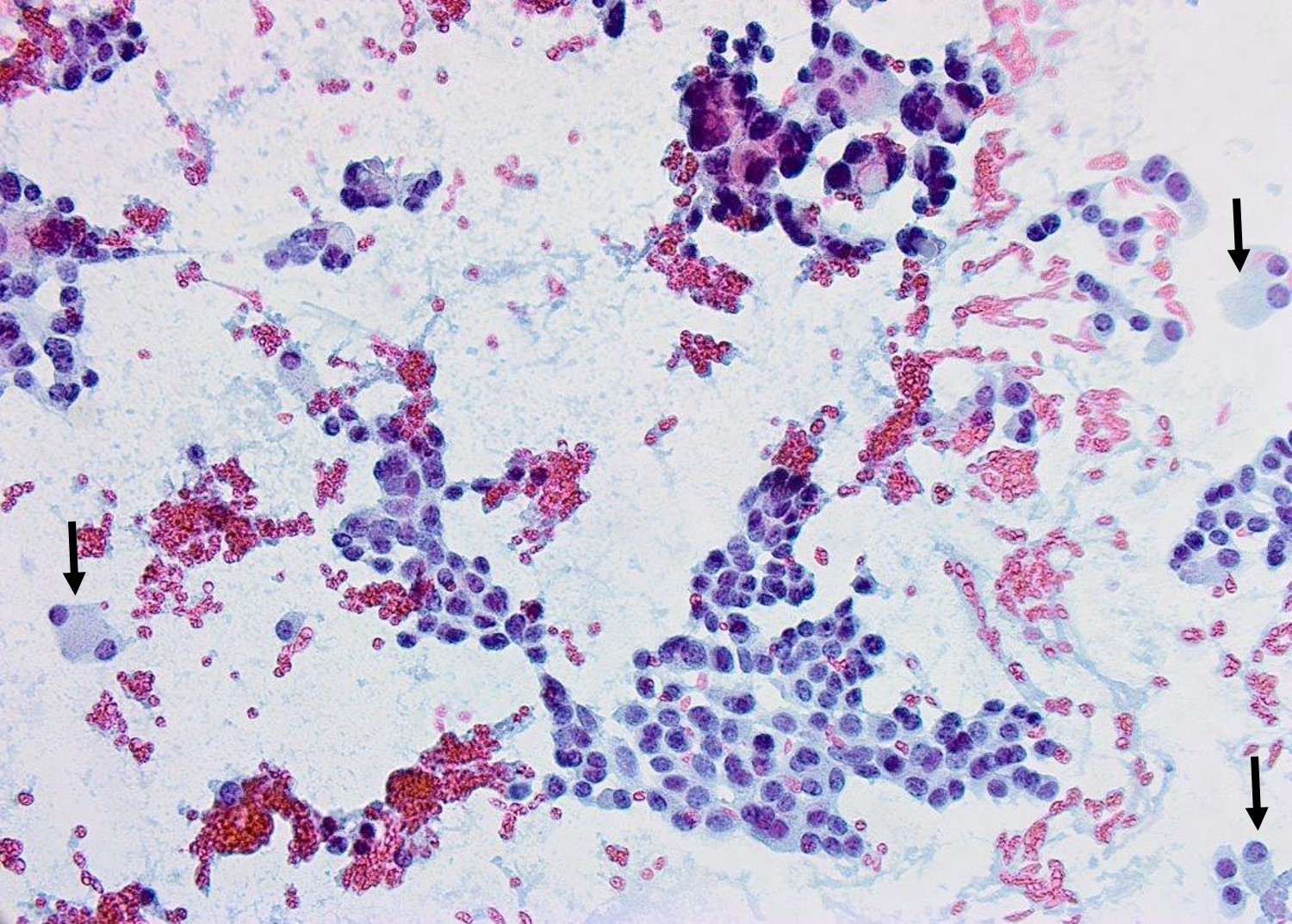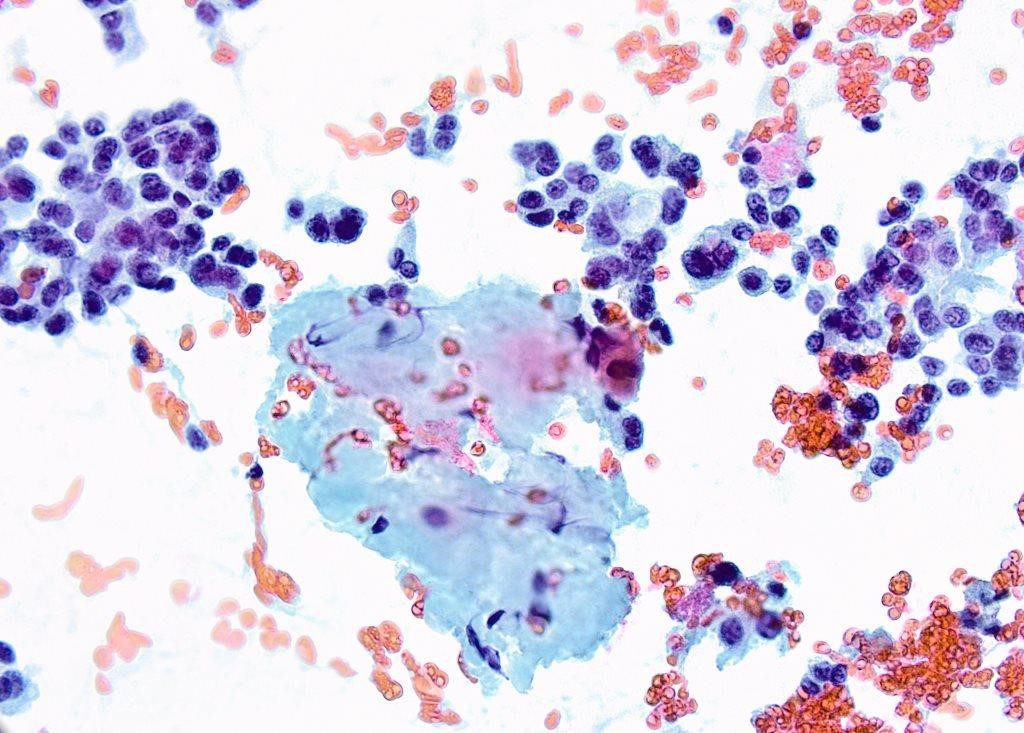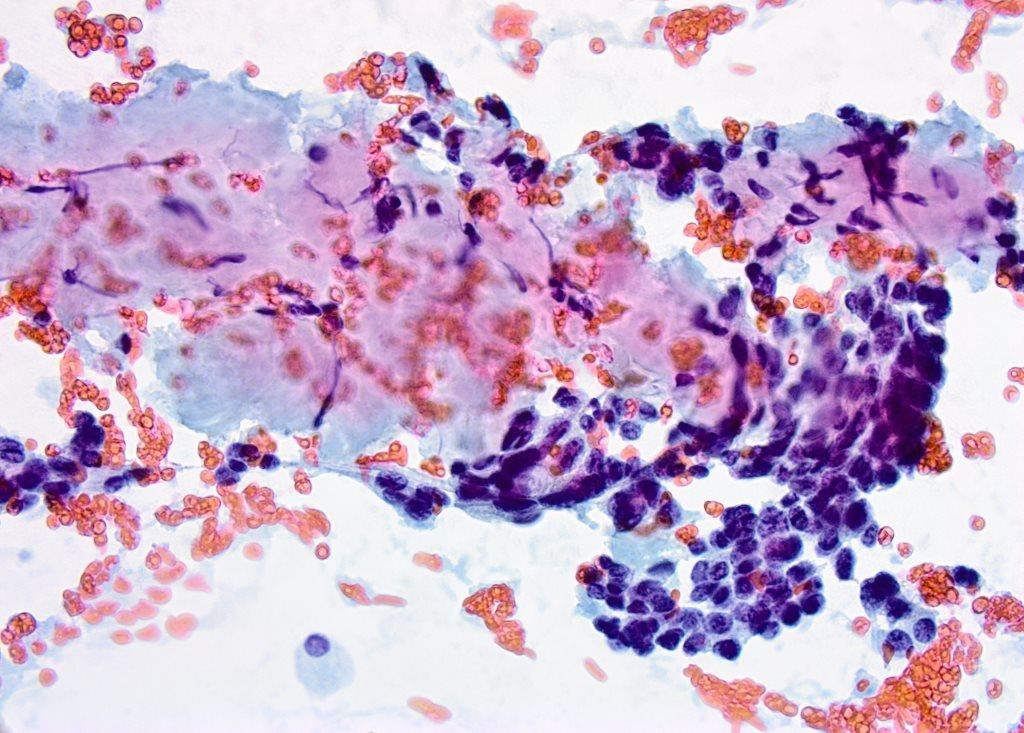Quiz Summary
0 of 3 questions completed
Questions:
Information
You have already completed the quiz before. Hence you can not start it again.
Quiz is loading…
You must sign in or sign up to start the quiz.
You must first complete the following:
Results
Results
0 of 3 questions answered correctly
Your time:
Time has elapsed
You have reached 0 of 0 point(s), (0)
Earned Point(s): 0 of 0, (0)
0 Essay(s) Pending (Possible Point(s): 0)
Categories
- Not categorized 0%
-
 Canadian Society of Pathology
Canadian Society of Pathology
Case Of The Month
Case and discussion contributed by:
Omar Al-Nourhji, MD, FRCPC
Assistant Professor
Department of Pathology and Laboratory Medicine
University of OttawaThe following images are representative of a thyroid gland mass fine needle aspiration. The patient is a 32-year-old female

Pap stained smear x40 
Pap stained smear x40 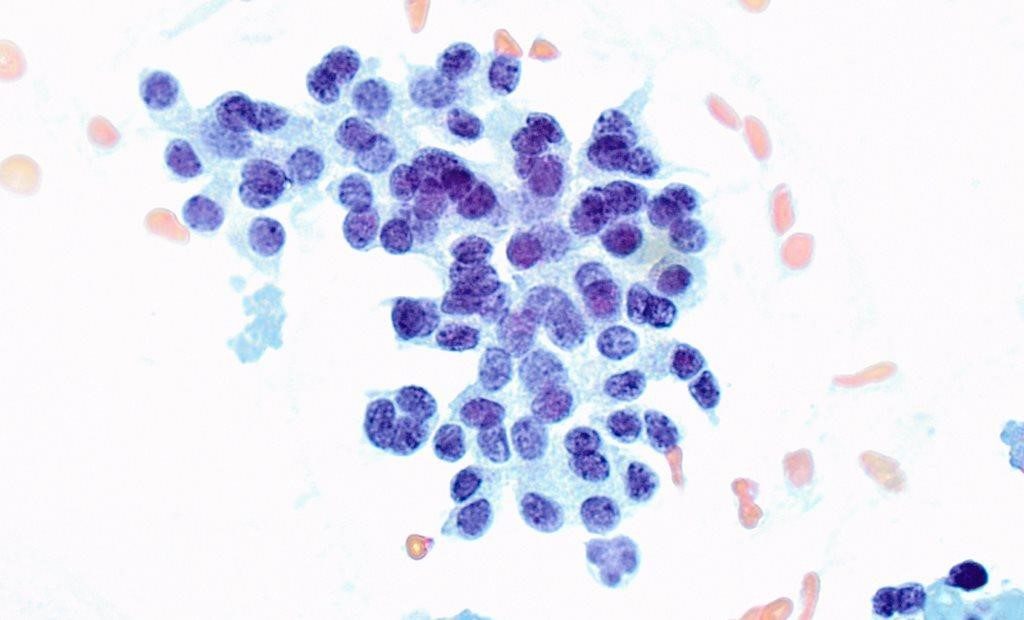
Pap stained smear X100 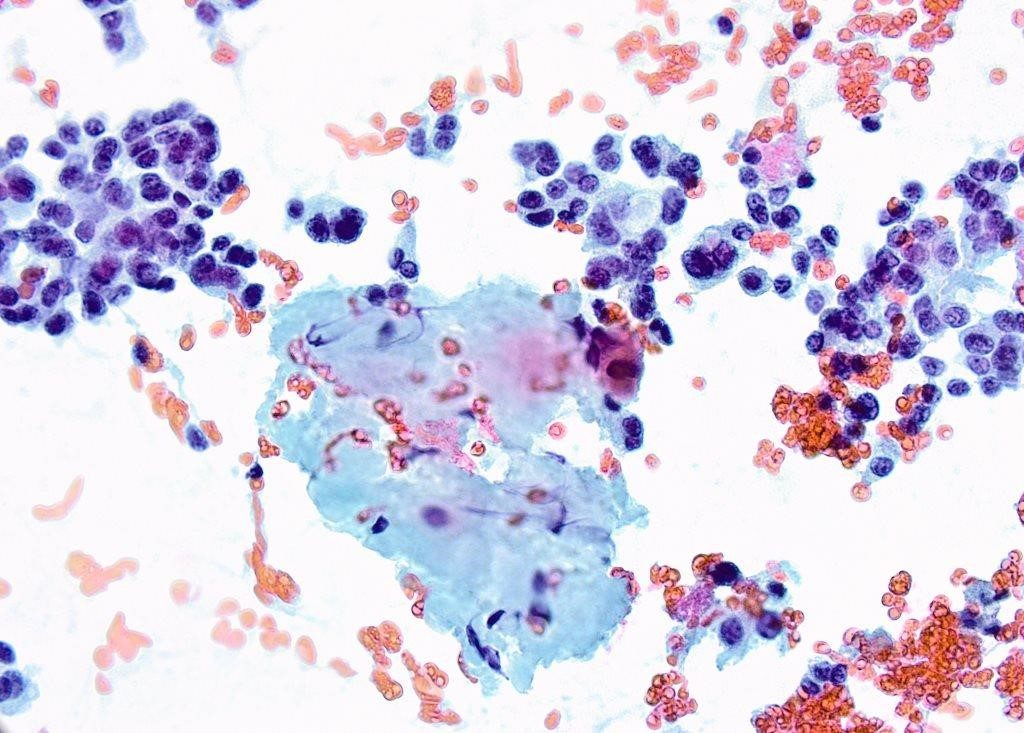
Pap stained smear X60 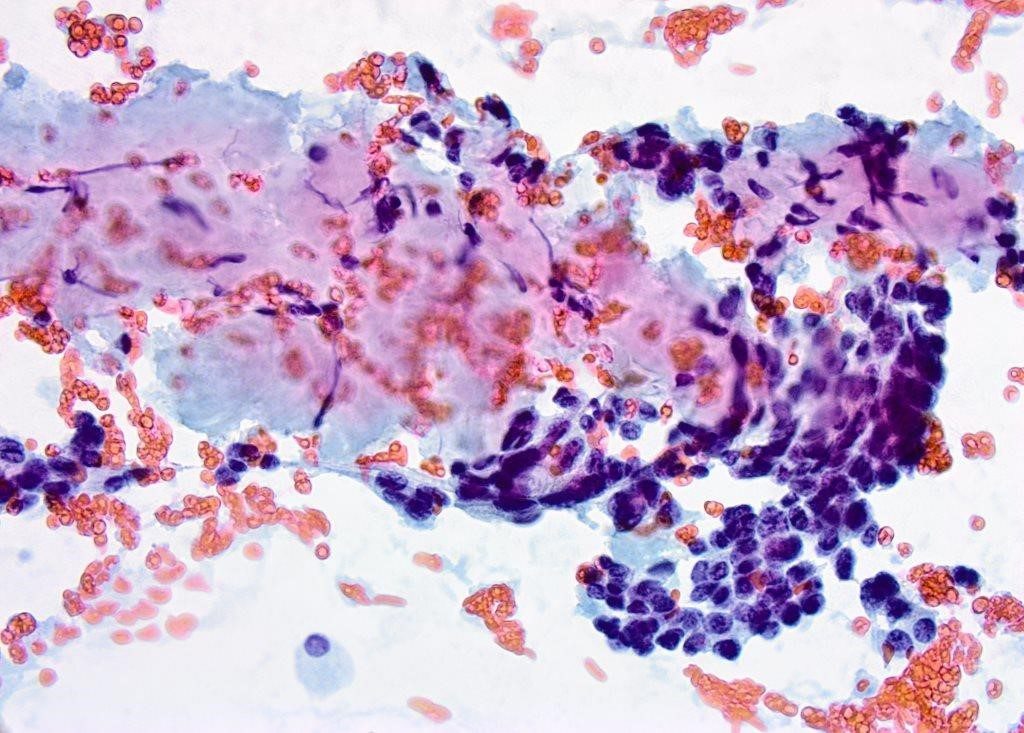
Pap stained smear X60 Lesional cells arranged in an organoid pattern with occasional small groups and single cells in the background. The individual cells are polygonal and contain uniform, round to oval nuclei and eosinophilic cytoplasm. Occasional single cells show a plasmacytoid morphology (arrows).
.
Syncytial-like flat sheet of lesional cells and occasional single lesional cells with plasmacytoid morphology (arrows).
Higher power view showing neoplastic cells with round to oval mildly pleomorphic nuclei with coarse granular chromatin (salt and pepper) and occasional small nucleoli.
Dense amorphic material (center) surrounded neoplastic cells with round to oval mildly pleomorphic nuclei and occasional cytoplasmic vacuoles.
Dense amorphic material (upper left) and groups of lesional cells (right). Such material when present in a cell block would display characteristic birefringence of amyloid on Congo red stain (not pictured).
Discussion
The images collectively show a cellular aspirate with organoid groups, syncytial-like flat sheets and occasional single neoplastic cells. Dense, amorphous material is noted focally in the background but no watery colloid is identified. The neoplastic cells are polygonal with occasional plasmacytoid morphology. On high power, coarsely granular (“salt and pepper”) chromatin is readily recognized. A prominent papillary architecture, intranuclear inclusions and psammoma bodies (characteristic features of PTC) are not identified. The focal plasmacytoid morphology, typical chromatin pattern and amorphous material should raise suspicion for a medullary thyroid carcinoma. The absence of a predominant microfollicular and/or trabecular architecture excludes follicular neoplasms. Hürthle cell neoplasms are characterized by an almost/completely pure Hürthle cell population, while anaplastic thyroid carcinoma usually demonstrates marked nuclear pleomorphism and multinucleated giant cells, all of these features are not recognized in the current case (1).
In characteristic cases, the diagnosis of MTC may be readily established based on morphologic features alone. In these cases, neoplastic cells can range from plasmacytoid, polygonal to spindle-shaped, and tend to demonstrate the classic “salt and pepper” chromatin pattern. Less frequent variants of MTC (clear cell, small cell, oncocytic and melanocytic to name a few) may be more challenging to recognize and include a broad differential diagnosis. For this reason and given the potential heritable implications of this diagnosis, confirmation with immunohistochemical staining and/or serum laboratory studies is worthwhile. Calcitonin is the most useful immunohistochemical marker with reported sensitivity of 74-100% (2-3). If feasible, calcitonin should be performed as part of a panel that additionally includes CEA, chromogranin (both positive in MTC but negative in other entities included in question 1) and thyroglobulin (expected to be negative in MTC). Amyloid material when present in the cell block may be stained with Congo red.
Medullary Thyroid Carcinoma (MTC) is a malignant neuroendocrine neoplasm of the thyroid gland derived from C-cells (parafollicular cells) of the ultimobranchial body. It comprises 1-3% of thyroid malignancies, far less than papillary thyroid carcinomas (85%) and follicular carcinomas (up to 10%). Although the majority of MTC cases (70-80%) are sporadic, up to 30% of cases are heritable. Sporadic cases of MTC occur in the 5th to 6th decades of life, and tend to present as a solitary and unilateral thyroid nodule. C-cell hyperplasia is usually absent. Somatic RET mutations have been identified in up to 50% of sporadic MTC. Heritable forms of MTC present at a younger age (usually third decade of life) with bilateral and multiple nodules. They are inherited in an autosomal dominant fashion as part of multiple endocrine neoplasia (MEN) type 2A, MEN type 2B and familial medullary thyroid carcinoma (FMTC). C-cell hyperplasia is usually identified in background thyroid. Germline mutations of the RET gene are identified in these cases.
The most recent guidelines of the American Thyroid Association (ATA) (4) recommend screening all patients with a new diagnosis of MTC for evidence of hereditary MTC via physical examination and RET mutational testing. Patients with evidence of hereditary MTC should be further evaluated for pheochromocytoma and hyperparathyroidism prior to ultimate surgical therapy. For this reason, a definitive diagnosis of MTC on cytological specimens is of greater importance prior to surgical management.
References
(1) Cibas ES, Ducatman BS. Cytology. Diagnostic Principles and Clinical Correlates. Fourth Edition (Elsevier Saunders, Philidelphia, 2015), p282-290
(2) Das DK, Mallik MK, George SS, et al. Secretory activity in medullary thyroid carcinoma: a cytomorphological and immunocytochemical study. Diagn Cytopathol. 2007;35: 329–337.
(3) Pusztaszeri MP, Bongiovanni M, Faquin WC. Update on the cytologic and molecular features of medullary thyroid carcinoma. Adv Anat Pathol. 2014 Jan;21(1):26-35
(4) Wells SA, Asa SL, Dralle H, et al; American Thyroid Association Guidelines Task Force on Medullary Thyroid Carcinoma. Revised American Thyroid Association guidelines for the management of medullary thyroid carcinoma. Thyroid. 2015;25:567-610.
- 1
- 2
- 3
- Current
- Review
- Answered
- Incorrect
-
Question 1 of 3
1. Question
The MOST LIKELY diagnosis is:
CorrectIncorrect -
Question 2 of 3
2. Question
Which of the following immunohistochemical stains is MOST HELPFUL is confirming the diagnosis?
CorrectIncorrect -
Question 3 of 3
3. Question
Which of the following genetic alterations is associated with this condition?
CorrectIncorrect

